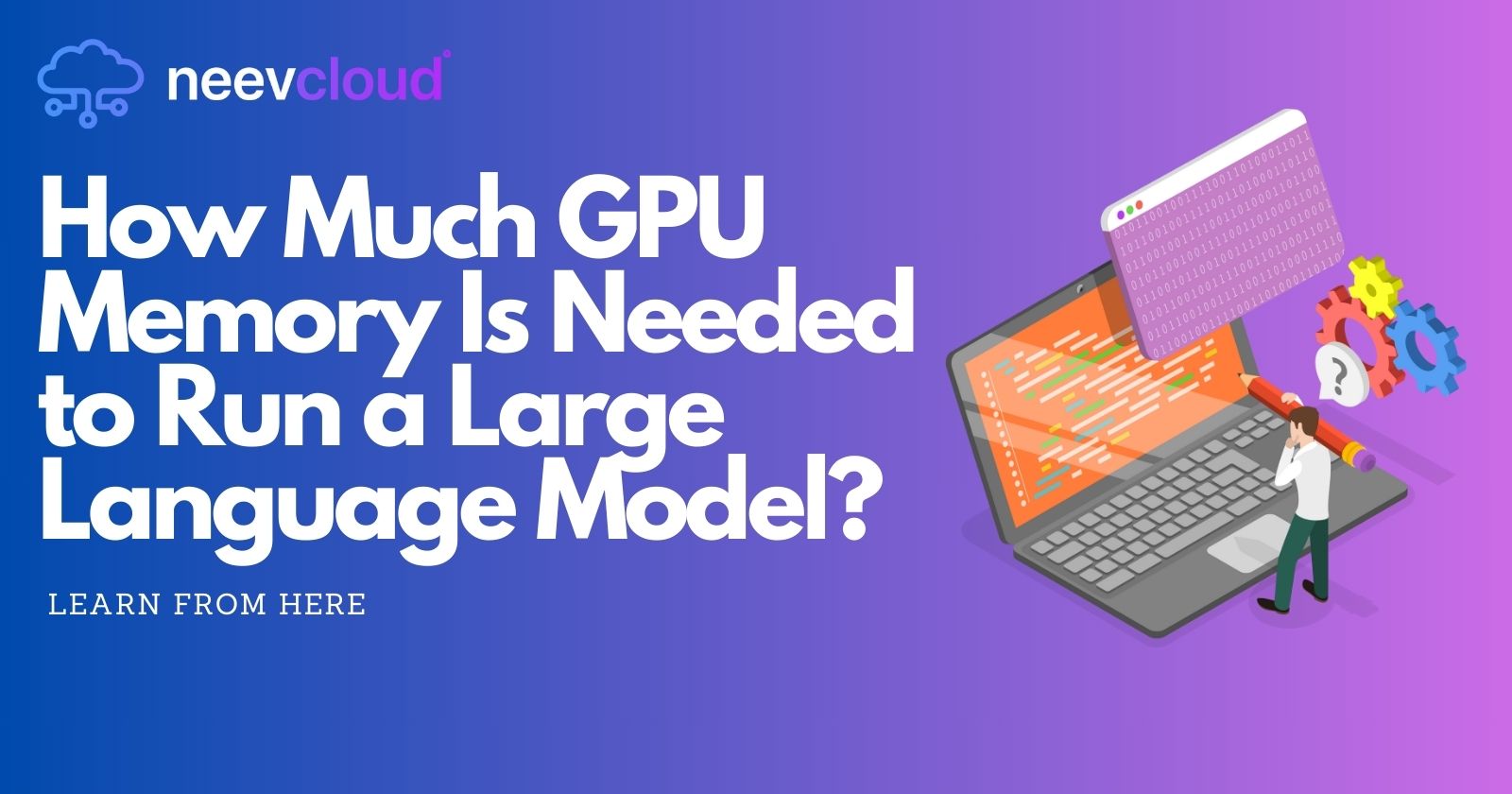How Much GPU Memory Is Needed to Run a Large Language Model? Learn More Here!
 Tanvi Ausare
Tanvi AusareTable of contents

LLMs like GPT, LLaMA, and PaLM push GPU memory to its limits, making efficient management critical for training and inference. This blog explains how much memory LLMs need, key factors that influence requirements, and how NVIDIA’s HGX H100 and H200 platforms power scalable AI in the cloud.
TL;DR: How Much GPU Memory Do You Really Need for LLMs?
GPU memory is the key limiter for LLM performance & scalability
Memory needs scale with model size, batch size, and precision (FP32, FP16, INT8)
Example: 1B params ≈ 2 GB | 7B ≈ 14 GB (FP32) | 65B ≈ 130 GB (FP32)
Training requires 100+ GB for large models; inference needs less but scales with deployments
NVIDIA HGX H100 (80 GB) and HGX H200 (100+ GB) are built for massive LLM workloads
Memory optimization: gradient checkpointing, mixed precision, tensor parallelism, offloading
AI Cloud (HGX-powered) delivers scalability, cost efficiency, and on-demand GPU access
Small models (≤7B params) can run on 24–40 GB GPUs; larger ones need multi-GPU or cloud setups
Running Large Language Models (LLMs) demands serious computational muscle, especially when it comes to GPU memory. As enterprises and researchers scale up their AI ambitions, understanding memory requirements is critical. LLMs like GPT, LLaMA, and PaLM operate on billions of parameters, making efficient memory management a top priority. Whether you're planning to run models on-premises or in the AI Cloud, this blog will explore how much GPU memory is necessary for running LLMs effectively, along with key infrastructure considerations such as NVIDIA’s latest HGX H100 and HGX H200 platforms. Let’s dive deeper!
Why GPU Memory Matters for LLMs
GPU memory, typically expressed in gigabytes (GB), serves as the workspace for both model parameters and intermediate computations during model training and inference.
In large models, every forward pass and backpropagation step involves massive matrix multiplications. Without sufficient memory, the model must offload data between the GPU and host RAM, introducing bottlenecks.
Training large models like OpenAI's GPT-4, Google’s PaLM, or Meta’s LLaMA-2 demands not only high GPU compute power but also large memory capacity to hold billions of parameters.
AI datacenter operators, especially those using NVIDIA hardware, must carefully consider GPU memory requirements to ensure workloads run efficiently without being bottlenecked by memory swapping.
Estimating Memory Needs for LLMs
Determining the memory required depends on three key factors:
Model Size (Parameters): Larger models, such as a 65-billion parameter LLaMA, will need significantly more memory than a 7-billion parameter model.
Batch Size: A higher batch size accelerates training but proportionally increases memory consumption.
Precision Format: Models can run in FP32, FP16, or more memory-efficient formats like INT8, with lower precision saving memory at the cost of potential performance loss.
Here’s a rough guideline on memory usage:
1 billion parameters: ~2 GB memory (FP32)
7 billion parameters: ~14 GB memory (FP32), ~7 GB (FP16)
65 billion parameters: ~130 GB memory (FP32), ~65 GB (FP16)
When training or fine-tuning very large models, the memory requirement can exceed 100 GB, necessitating AI Cloud solutions or multi-GPU setups. This is where powerful GPUs like NVIDIA’s HGX platforms come into play.
NVIDIA HGX Platforms for LLMs: A Game-Changer
NVIDIA’s HGX series offers unmatched computational power and memory bandwidth, making them ideal for LLM workloads. Let’s explore the NVIDIA HGX H100 and the upcoming HGX H200, key components of modern AI datacenters.
NVIDIA HGX H100: Designed for AI Cloud and Datacenter Workloads
The HGX H100 platform is built around the NVIDIA H100 Tensor Core GPU, optimized for LLM training and inference.
With up to 80 GB of HBM2e memory per GPU, the HGX H100 allows high-performance training of multi-billion parameter models without running into memory constraints.
The platform supports mixed precision computing (FP16, INT8, and FP8) to improve memory efficiency and accelerate training.
Pricing for the NVIDIA HGX H100 varies, but it typically falls in the $30,000-$40,000 range, depending on configuration and market trends.
NVIDIA HGX H200: The Future of AI Datacenter Computing
NVIDIA is gearing up to release the HGX H200, which promises even more memory and compute power for next-generation AI workloads.
With enhanced interconnects and increased memory bandwidth, the HGX H200 will address the growing demand for real-time LLM deployments and high-performance AI research.
Early estimates suggest the Nvidia HGX H200 Price will likely start above $50,000, targeting elite AI researchers and large-scale AI Cloud providers.
Memory Requirements for Training vs. Inference
Training: During model training, the GPU memory must store both the model parameters and activations from each layer of the neural network. This means the memory footprint is much higher compared to inference. Multi-GPU setups are often required for large models.
Inference: Inference requires only the forward pass of the neural network, meaning memory consumption is significantly lower than training. However, large-scale deployments can still need substantial memory to process multiple requests simultaneously or to support large batch sizes.
Using AI Cloud services is a viable option for companies that need scalability. Cloud providers offering NVIDIA-powered infrastructure, such as those built on HGX H100, allow organizations to rent the power they need without upfront hardware costs.
Techniques to Optimize GPU Memory Usage
Even with powerful GPUs, managing memory efficiently is essential for smooth LLM training. Here are some techniques to reduce memory usage:
Gradient Checkpointing: This method saves GPU memory by not storing intermediate activations for all layers, recomputing them on-the-fly during backpropagation.
Mixed Precision Training: Reducing precision from FP32 to FP16 or lower can cut memory usage by half without significant loss in model performance.
Tensor Parallelism: Splitting the model across multiple GPUs to balance memory and computation load.
Offloading to CPU: Some frameworks allow offloading certain parts of the model to CPU memory, freeing up GPU memory for essential computations.
AI Datacenters with NVLink: NVIDIA’s NVLink technology enables fast communication between GPUs, making multi-GPU training more efficient.
Scaling LLMs in the AI Cloud with NVIDIA GPUs
LLM workloads are pushing the limits of what a single GPU can handle. In AI datacenters, multiple NVIDIA HGX H100 or H200 nodes are connected to support parallel processing. Here’s how companies benefit from using AI Cloud infrastructure:
Scalability: AI Cloud providers offer scalable infrastructure that can grow with the user’s needs.
On-Demand Access: Renting GPUs in the cloud eliminates the high upfront costs associated with deploying NVIDIA HGX systems in-house.
Cost Optimization: Cloud-based LLM training allows organizations to pay only for the resources they use, improving budget management.
NVIDIA’s HGX H100 and H200 platforms are becoming the backbone of many AI Cloud providers, allowing enterprises to build state-of-the-art LLMs and deploy them globally. These platforms offer unmatched performance, memory, and flexibility for any business involved in AI datacenter operations.
Conclusion: How Much GPU Memory Do You Really Need?
For smaller LLMs with up to 7 billion parameters, 24-40 GB of GPU memory might suffice, making a single A100 or H100 GPU feasible.
Models with 65 billion parameters or more will need 80-100 GB per GPU or require multi-GPU setups, ideally leveraging platforms like NVIDIA HGX H100 or HGX H200.
If you’re running cutting-edge research or deploying complex models at scale, investing in a multi-GPU cluster or leveraging an AI Cloud provider with NVIDIA GPUs becomes essential.
Choosing the right GPU memory setup depends on your workload, budget, and deployment strategy. Whether you opt for on-premises NVIDIA HGX hardware or scale through the cloud, ensuring enough memory is the key to achieving efficient, high-performance LLMs. Keep an eye on the Nvidia HGX H100 price for your current needs, and consider the upcoming HGX H200 for future-proofing your infrastructure.
If you're looking to scale smartly without breaking the bank, explore the cheapest GPU cloud options that still deliver top-tier performance.
Stay tuned to NeevCloud for more insights on cutting-edge AI Cloud technologies and how you can optimize your AI workloads!
Subscribe to my newsletter
Read articles from Tanvi Ausare directly inside your inbox. Subscribe to the newsletter, and don't miss out.
Written by
